Late Triassic sauropodomorph and Middle Jurassic theropod tracks from the Xichang Basin,Sichuan Province,southwestern China:First report of the ichnogenus Carmelopodus
Li-Da Xin,Jin Ba,Martin G.Lockly,Hnrik Klin,Sn-Wu Yan,Antony Romilio,Cun-Yon Cou,W.Scott Prsons IV
aState Key Laboratory of Biogeology and Environmental Geology,China University of Geosciences,Beijing 100083,China
bSchool of Earth Sciences and Resources,China University of Geosciences,Beijing 100083,China
cState Key Laboratory of Palaeobiology and Stratigraphy,Nanjing Institute of Geology and Palaeontology,Chinese Academy of Sciences,Nanjing 210008,Jiangsu Province,China
dSichuan Institute of Geological Survey,Chengdu 610081,Sichuan Province,China
eDinosaur Trackers Research Group,University of Colorado Denver,PO Box 173364,Denver,CO 80217,USA
fSaurierwelt Paläontologisches Museum,AlteRicht 7,D-92318 Neumarkt,Germany
gSchool of Biological Sciences,The University of Queensland,Brisbane,Queensland 4072,Australia
hDepartment of Biological Sciences,University of Alberta,116 St&85 Ave,Edmonton AB T6G 2R3,Alberta,Canada
Abstract Upper Triassic and Middle Jurassic strata of the Xichang Basin in Sichuan Province,southwestern China,yielded important dinosaur ichnofossils.From the Xujiahe Formation of the Yiguojiao tracksite,we report a Late Triassic footprint assemblage in China and the first discovery of diagnostic Triassic sauropodomorph tracks in this region.The tracks share a number of features in common with the ichnogenera Eosauropus(Late Triassic)and Liujianpus(Early Jurassic).The neighboring Bingtu tracksite is stratigraphically younger(Shaximiao Formation,Middle Jurassic)and preserves small tridactyl theropod tracks that represent the first occurrence of the ichnotaxon Carmelopodus in China and Asia.While these tracks are morphologically comparable to those from the Middle Jurassic type locality in North America,the specimens from China show the proximal margin of the digit IV impression in a more cranial position,which may indicate a trackmaker with a relatively short metatarsal IV.In addition to the skeletal record,the Carmelopodus footprints document the presence of small theropods in the dinosaur fauna of the Middle Jurassic Shaximiao Formation.
Keywords Sauropodomorph,Theropod,Footprint,Ichnofossil,Upper Triassic Xujiahe Formation,Middle Jurassic Shaximiao Formation,Xichang Basin,Sichuan Province
1. Introduction
Few Late Triassic tetrapod tracksites are known from China,with only one site(the Pengxianpus site;Yang and Yang,1987)known prior to 2013(Matsukawa et al.,2006).Since 2013,the Pengxianpus site was reexamined and further three Late Triassic sites were reported(Xing et al.,2013a,2014a,2014b)in addition to two records from Middle Triassic strata that include Chirotherium trackways(Lockley and Matsukawa,2009;Lü et al.,2004;Xing et al.,2013b)and possible nothosaur foraging tracks(Huang et al.,2012;Zhang et al.,2014).While tetrapod ichnofaunas from Late Triassic—Early Jurassic boundary sequences of China have been described in several papers,footprints of sauropodomorphs were almost unknown,except of a trackway of a possible bipedal archosaur from the Late Triassic of the Sichuan Basin that shows some resemblance of the sauropodomorph ichnogenus Eosauropus(Xing et al.,2014b).In contrast,the global Triassic record of sauropodomorph tracks lists numerous occurrences in both Late Triassic and Early Jurassic deposits(Li et al.,2012;Xing et al.,2014c,2016a,2016b,2016c).Herein we describe sauropodomorph footprints from a new location,the Yiguojiao site of the Triassic—Cretaceous Xichang Basin(Fig.1),which represents another significant Late Triassic tetrapod tracksite reported from China(Fig.1).This study is also an additional discovery from the Bingtu tracksite in the Xichang Basin that belongs to younger deposits of the Middle Jurassic Shaximiao Formation(formerly “Xiashaximiao Formation”;the prefixed “Xia” means “Lower”).From this locality,tridactyl theropod tracks,attributable to Carmelopodus,are documented.This is the first known occurrence of this ichnogenus in China.
The Xichang Basin is known for Cretaceous fossils,and prior to this report,Triassic or Jurassic dinosaur fossils were unknown,despite the extensive dimensions of this depression(roughly 16,000 km2)that includes Shimian,Xide,Zhaojue,and Meigu counties(Fig.1;Fu and Qin,2011;Liu et al.,2003),and borders the southwestern region of the fossil-rich Sichuan Basin.Since 2013,abundant Cretaceous dinosaur tracks have been found in the Jiangzhou—Mishi subbasin of the Xichang Basin,that include theropod,sauropod,ornithopod,turtle and pterosaur tracks(Xing and Lockley,2016).In contrast,track records from the Emei—Zhaojue sub-basin are sparse with only a single Early Cretaceous theropod tracksite that has been previously reported(Xing et al.,2016d).
In August 2016,during the 1:50,000 regional geological survey of the Wumeng mountainous area,the Sichuan Institute of Geological Survey discovered dinosaur tracks at the base of the Middle Jurassic Shaximiao Formation in the Emei—Zhaojue sub-basin.This site is located near Lemenhaluo Village(GPS:28°34′2.02′′N,103°0′28.16′′E),Bingtu Township,Meigu County in Yi Autonomous Prefecture of Liangshan.In September,a survey team found a second occurrence of dinosaur tracks approximately 12.2 km northeast of the Bingtu tracksite.This tracksite occurs at the top of the Upper Triassic Xujiahe Formation in the Emei—Z-haojue sub-basin,and is located near Wadule Village,Yiguojue Township,Meigu County(GPS:28°39′50.21′′N,103°4′2.90′′E;Fig.1).Yan et al.(2017)briefly described the Bingtu tracksite,but did not provide morphologic details.
2. Geological setting
The Xichang Basin is positioned at the western edge of the Upper Yangtze Platform and belongs to the Tethyanstructuraldomain.The Hanyuan—Ganluo fracture zone divides the Xichang Basin into eastern and western sub-basins known as the Emei—Zhaojue and the Jiangzhou—Mishisub-basins,respectively(Wang and Li,1996).All tracks described in this paper are from the Emei—Zhaojue sub-basin.In this subbasin,Triassic and Jurassic strata are consistent with those in the adjacent Sichuan Basin,and the outcrops mainly belong to the Upper Triassic(Rhaetian)Xujiahe Formation with only a few Jurassic locations(Fig.2;Peng et al.,2005;Qiao et al.,2012).The Jurassic strata consist of two Lower Jurassic formations(Zhen zhu chong Formation and Ziliujing Formation),two Middle Jurassic formations(Xintiangou Formation and Shaximiao Formation),and two Upper Jurassic formations(Suining Formation and Penglaizhen Formation)(Gu et al.,1997;Li et al.,2011).
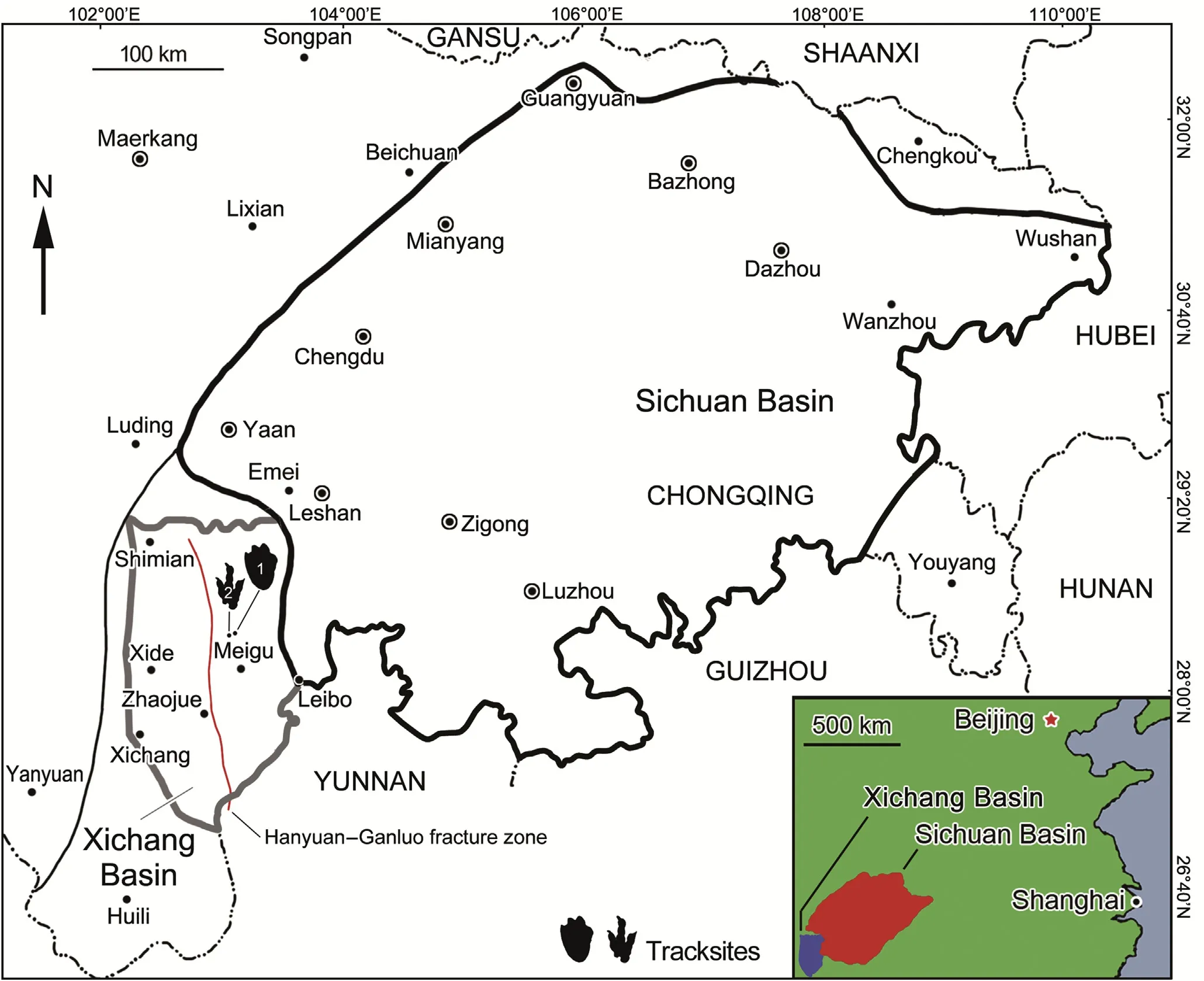
Fig.1 Map showing the geographic position of footprint localities(footprint icon),the Yiguojiao tracksite(1)and the Bingtu tracksite(2)in Sichuan Province,southwestern China(modified from Xing and Lockley,2016,their Fig.1).Black thick solid line indicates outline of the Sichuan Basin;grey thick solid line indicates outline of the Xichang Basin;red line indicates the Hanyuan—Ganluo fracture zone.
2.1. Yiguojiao tracksite
The Xujiahe Formation is composed primarily of yellowish grey sandstone and mudstone interbedded with coal layers,forming rhythmic beds of alternating thicknesses.The formation varies in total thickness from 450 m to 3000 m.Body fossils occur with bivalves,brachiopods,ostracods,conchostracans,gastropods,and plants(Xing et al.,2014b).The Xujiahe Formation in the Emei—Zhaojue sub-basin begins with a 10—20 cm thick yellowish grey conglomeratic sandstone bed(mostly middle-to coarse-grained lithic quartz sandstone).Its contact with the underlying Middle Triassic Leikoupo Formation is a paraconformity(i.e.,parallel and without significant erosion).The Lower Jurassic Ziliujing Formation conformably overlies the Xujiahe Formation.
The Xujiahe Formation can be divided into two lithologically distinct members(Wang and Li,1996).The lower member is characterized by a cyclothem composed of off-white,coarse-grained,feldspathiclithic quartz sandstone, fine-grained feldspar quartz sandstone,grey siltstone,black carbonaceous shale with coallayers, and particularly large crossbedding.The upper member is characterized by a sedimentary cycle comprising grey fine—mediumgrained feldspathic-lithic quartz sandstone,siltstone,mudstone and carbonaceous shale,which shows coarse— fine—coarse granularities from bottom to top across the basin(Fig.2).
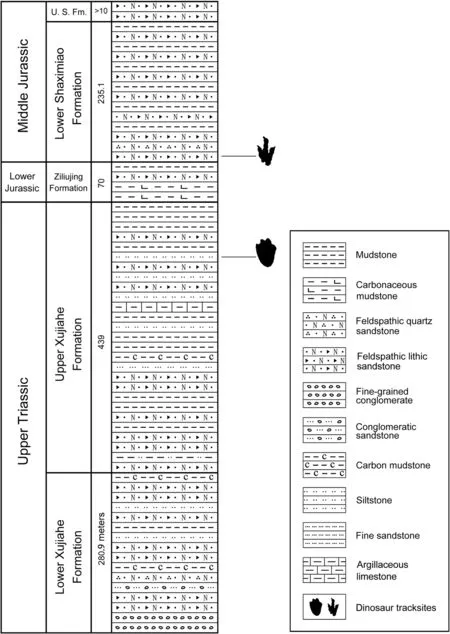
Fig.2 Composite stratigraphic section of Upper Triassic—Middle Jurassic series at the Yiguojiao tracksite(lower track icon)and the Bingtu tracksite(upper track icon).U.S.Fm.=Upper Shaximiao Formation.
The tracks are preserved on top of the silty mudstone in the upper sequence of the Xujiahe Formation of the Wadule Village area,about 90 m below the conformable contact with the overlying Ziliujing Formation.The upper surface preserves a rich fossil flora and the bottom is thickly layered grey feldspathic-lithic quartz sandstone.
2.2. Bingtu tracksite
The Shaximiao Formation is widely exposed in the Sichuan Basin(Gu et al.,1997).The Shaximiao Formation was divided into the Middle Jurassic Xiashaximiao(Lower Shaximiao;the prefixed “Xia” means“Lower”)Formation and the Upper Jurassic Shangshaximiao(Upper Shaximiao;the prefixed “Shang”means “Upper”)Formation,because of the large thickness but monotonous lithology(Compiling Group of Continental Mesozoic Stratigraphy and Palaeontology in Sichuan Basin of China,1982).However,there has been a controversy about the geological age of the Upper Shaximiao Formation for years.Based on invertebrates(bivalves,conchostracans,ostracods),the whole Shaximiao Formation was assigned to the Middle Jurassic(Wang et al.,2008).Based on the vertebrate record,Peng et al.(2005)consider a Middle Jurassic age for the Lower Shaximiao Formation,and a Late Jurassic age for the Upper Shaximiao Formation.
The formalization as the Xiashaximiao and Shangshaximiao formations is problematic because lithostratigraphic names are locations,and the prefixes reflect the relative position in the stratigraphic column,whereas there is no place called for example“Xiashaximiao” (Xing et al.,2014c;and personal communication with S.G.Lucas in 2013).Li et al.(2011)considered the entire Shaximiao Formation to be Bajocian—Callovian in age(middle—late Middle Jurassic),with the Upper Shaximiao Formation representing the Bathonian—Callovian interval. This conclusion is supported by the age inferred from invertebrate fossils and radiometric dating(178—165 Ma)(electron spin resonance analyses;Gou and Shi,1997;Gou et al.,2000).The Lower Shaximiao Formation is characterized by a rhythmic bedding of variable thicknesses formed by yellowish grey blocky sandstone and purplish red siltstone,with parallel bedding and small cross bedding.
The Bingtu tracks are preserved in dark grey thinlayered silty mudstone near the base of the Shaximiao Formation,in the Lemenhaluo Village area.Here,the tracksite is about 30 m above the parallel unconformable contact with the underlying Ziliujing Formation.
2.3. Evolution of the Xichang Basin
The Late Triassic Xichang Basin is a peripheral foreland basin(Qin,2009)with terrigenous coarse clastic rocks,represented by the Baiguowan Formation(Jiangzhou—Mishi sub-basin)and the Xujiahe Formation(Emei—Zhaojue sub-basin).From the Early to the Late Triassic,the sedimentary environment changed from fluvial plain to alluvial plain.Late-stage alluvial plain facies deposits in the Xichang Basin are characterized by coal production(Hu et al.,1974).
In the Early Jurassic,the Xichang Basin largely retained the same basic structure as in the Late Triassic,but with increasing aridity which led to inland sand—mudstone deposition,as represented by the Yimen Formation(Jiangzhou—Mishi sub-basin)and the Ziliujing Formation (Emei—Zhaojue sub-basin).Generally speaking,the lower part of the Lower Jurassic unit is a lake shore deposit,represented by red clastic rocks,and the upper part is a sedimentary assemblage formed by calcarenite interbedded with shale and siltstone,indicating that rapid depression had expanded the basin into a lake.During the Late Triassic and the Early Jurassic,the climate shifted from more humid to arid(Fu and Qin,2011).
After uplift at the end of the Early Jurassic,the Xichang Basin underwent a general subsidence,shifting from a foreland basin to an intra continental depression basin,during the Middle Jurassic.The maximum expansion may have happened during deposition of the Xincun—Niugundang Formations(Jiangzhou—Mishi sub-basin) and the Shaximiao—Suining Formations(Emei—Zhaojue sub-basin),between the depositional period of the Middle Jurassic and the early Upper Jurassic.During this time,the climate was again more humid(Xia et al.,1984),and sedimentary deposits are dominated by shallow lake,grayish purple sandstone and shale,with oolitic hematite and multiple layers of low-energy deposition,as represented by black,dark grey,or gray green shale and limestone.
3. Materials and methods
Track parameters including maximum track length and width,divarication angle,pace and stride length(as per Lockley,2009;Marty,2008),were measured onsite,with track morphology and relative position recorded using acetate sheeting(as per Xing et al.,2013c).
The Yiguojiao track-bearing surface was digitally photographed(total of 11 photographs)under natural lighting conditions using an iPhone 5c.Photographic jpg image files were added to Agisoft Photoscan Professional Edition(version 1.2.6 build 2038 64 bit)to generate a scale-corrected model.The track model was applied with a false-color elevation filter using Paraview(version 5.0.0 64 bit)to visualize surface height.
4. Late Triassic sauropodomorph tracks
4.1. Description
The Yiguojiao tracksite preserves at least seven sauropodomorph tracks( five pedal traces and two manual traces)(Figs.3 and 4A).Possibly,four of these tracks represent one trackway(YGJ-S1),however,this cannot be proven because of the small sample.Alternatively this could be an accidental arrangement and overlap of different trackways.Two other imprints are interpreted here as an isolated set(YGJ-SI1p and YGJSI1m;Fig.3C).YGJ-S1 is a moderately well preserved,configuration of casts,although the outline of the track designated possible S1-LP1 is shown as a dashed line because the morphology is difficult to interpret.The mean manual and pedal impression lengths of YGJS1 are 15.4 cm and 41.1 cm,respectively.The average length/width ratios of the manual and pedal impressions are 0.7 and 1.4,respectively(Table 1).
The semi-circular shaped manual imprints are poorly preserved and show blurry digit impressions,their posterior margins being overprinted by the pes imprints.Pes impressions are oval in shape,with distinct digit traces I—IV.Claw traces are best developed in digits I—III.The posterior margin of the metatarsophalangeal area is smoothly rounded.If YGJS1 is truly a trackway,the manual impressions would be rotated approximately 70°outward relative to the trackway axis,while the pedal impression would be variably inwardly rotated(approximately 38°);the average pace angulation would be 92°(based on the pedal impressions).The maximum ratio of manual:pedal impression length is 1:3.4 when based on the specimen YGJ-SI1m which shows subtle digit traces(Fig.3).
4.2. Comparisons and discussion
Late Triassic—Early Jurassic sauropodomorph tracks are rare in China.Previous records include:Possible Eosauropus,from the Upper Triassic Xujiahe Formation of Zigong,Sichuan Province(Fig.4C;Xing et al.,2014b);Liujianpus,from the Lower Jurassic Ziliujing Formation of Gulin,Sichuan Province(Xing et al.,2016a);and Brontopodus-type trackways,from the Lower Jurassic Zhenzhuchong Formation of Dazu,Chongqing(Xing et al.,2016b).While all are regarded as produced by sauropodomorphs,track formation may have resulted from either bipedal(e.g.,Zigong)orquadrupedal(e.g.,Gulin and Dazu)trackmakers.
While sauropodomorph ichnofossils have been found in the Upper Triassic Xujiahe Formation,numerous body fossils attributable to the basal sauropodomorph Lufengosaurus have been discovered in the Lower Jurassic Lufeng Formation(Young,1951).This suggests that basal sauropodomorphs in southwestern China had a stratigraphic range from the Upper Triassic to the Lower Jurassic(Xing et al.,2014a).

Fig.3 Surface with sauropodomorph tracks cf.Eosauropus(YGJ-S1)in the Xujiahe Formation(Upper Triassic)at the Yiguojiao tracksite.A—Orthophotograph;B—3D height map(warm to cool colors represent low to high elevation of 14 cm);C—Interpretative outline drawing.
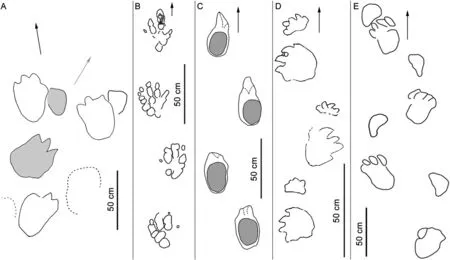
Fig.4 Comparison between Upper Triassic—Lower Jurassic sauropodomorph trackways from different localities.A— Possible trackways cf.Eosauropus from the Xujiahe Formation at the Yiguojiao tracksite,Xichang Basin,southwestern China;B—Otozoum from the Lower Jurassic of Namibia(D'OraziPorchetti et al.,2015);C—?Eosauropus trackway from the Xujiahe Formation of the Sichuan Basin,southwestern China(Xing et al.,2014b);D—Eosauropus from the Upper Triassic(Chinle Group),New Mexico(Lockley et al.,2006a,b);E—Liujianpus from the Lower Jurassic of the Sichuan Basin,southwestern China(Xing et al.,2016a).Arrows indicate direction of movement.
The first ichnogenus confidently attributed to a prosauropod was Otozoum(Fig.4B),which was named by Hitchcock(1847).In a revision of Hitchcock(1847,1858),Lull(1904,1953)diagnosed Otozoum as a prosauropod track and erected the ichnofamily Otozoidae.More recent work by Rainforth(2003),Lockley et al.(2006a)and others have unambiguously supported the basal sauropodomorph affinity of Otozoum.At present,the plexus of tracks attributed to basal sauropodomorphs includes Otozoum, Pseudotetrasauropus,Evazoum and Kalosauropus and has been dubbed as the OPEK plexus(Lockley et al.,2006b),which belongs to the ichnofamily Otozoidae(Lockley and Lucas,2013;Lockley et al.,2006a).The manual—pedal tracks of YGJ are distinct from those of OPEK plexus by the lack of long digits and more slender overall-shape,commonly seen in the OPEK plexus tracks;unlike to the latter,they rather show some sauropod-like features,such as the short,triangular digits and the oval,broad sole,indicating a fleshier pes.The YGJ tracks more closely resemble Eosauropus(Fig.4D)or Liujianpus(Fig.4E).
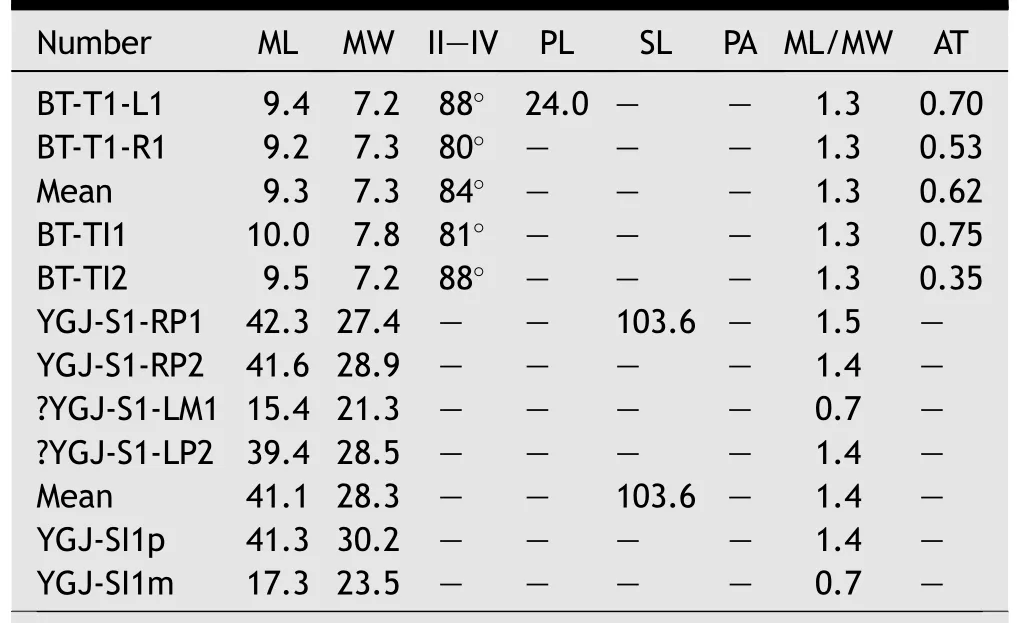
Table 1 Measurements(in cm)of theropod tracks from the Bingtu tracksite(BT),and sauropodomorph tracks from the Yiguojiaotracksite(YGJ),the Xichang Basin,southwestern China.
Lockley et al.(2006a)introduced the ichnogenus Eosauropus and suggested that various Northern Hemisphere reports of “Tetrasauropus” should be referred to Eosauropus.The Eosauropus morphology has a strong affinity to Sauropoda due to short,curved and outwardly rotated pedal digit impressions,the“ fleshy” overall-shape and the quadrupedal gait of the trackmaker(Fig.4D).It differs from the OPEK plexus ichnogenera that have elongate pedal digit impressions with distinct digital pad imprints and trackways that reflect a predominantly bipedal gait.Recently,Eosauropus has been described from the Upper Triassic Fleming Fjord Formation of Greenland and was attributed to early sauropods,among other features by the extreme outward rotation of the pes imprints(Lallensack et al.,2017).
Although some tracks are well preserved as natural casts(Fig.3A),the possible trackway sequence needs to be interpreted with some caution(Fig.4).The cross cutting relationships of these tracks in a small area means that inferences about pace angulation and track rotation are tentative.Furthermore,the presence of different trackways/individuals cannot be excluded.Nevertheless the YGJ tracks are similar to Eosauropus in:(1)strong heteropody(pedal impression larger than manual impression),the ratio of manual-to pedalimprint size being 1:3.8(Eosauropus)versus 1:3.4(YGJ tracks);(2)elongate,oval,and tetradactyl pedal impression;(3)transverse manualimprint with outwardly-rotated digit impressions.
The YGJ tracks are similar to Liujianpus in:(1)strong heteropody;(2)semi-circular manual imprint being strongly rotated outward.However,the YGJ tracks also lack some features of Liujianpus(Xing et al.,2016a):(1)relative length of digit imprints being III>IV=II>I;(2)imprinted plantar surface divided by a transverse crease;(3)four nearly equidimensional,elongate pedal digit traces oriented subparallel to the track axis.
Generally,the most notable features of the YGJ tracks are(1)strong heteropody;(2)manus impressions strongly outwardly rotated;(3)well-developed digit and claw prints.Compared with imprints of the Early Jurassic Liujianpus,YGJ may be morphologically closer related to the Late Triassic Eosauropus.Further discussion is difficult due to the small sample size,and we tentatively refer the YGJ tracks to cf.Eosauropus.
5. Middle Jurassic theropod tracks
5.1. Description
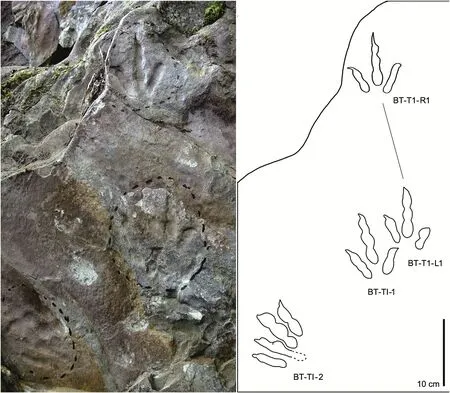
Fig.5 Carmelopodus tracks(BT-T1)from the Bingtu tracksite,Shaximiao Formation(Middle Jurassic)of the Sichuan Basin,southwestern China,photograph and interpretative outline drawing.
The Bingtu tracksite reveals four tridactyl tracks preserved as natural molds(Fig.5).The track length is 9.3 cm,the length/width ratio is 1.4,the divarication angle is 84°,and the anterior triangle length/width ratio is 0.62(average values).BT-T1-R1 is the best preserved track.The impression of digit III is directed anteriorly and is the longest,whereas that of digit II is shorter than digit IV.Digit II and digit III impressions possess two and three digit pad traces,respectively.The trace of digit IV lacks distinct digit pad impressions.A metatarsophalangeal pad impression is missing.Close to the digit IV impression of BTTI2,an overlapping second track is preserved by an isolated digit.The Bingtu tracks share some features seen in other tridactyl ichnotaxa,such as Anomoepus LQ-T2 from the Lower Jurassic Fengjiahe Formation of Yunnan(Xing et al.,2016e)or Chongqingpus V1394-5 from the Middle Jurassic Shaximiao Formation of Chongqing(Xing et al.,2013c).It is notable that digit IV traces are short with less posterior extension that is usually found in typical Grallator-like tracks of this age(Xing et al.,2013c).
Because of the similar length and inward rotation characteristics,BT-T1-L1 and BT-T1-R1 constitute a step,24 cm long,without associated manual tracks or tail traces.Supposing that the length of a stride equals that of two steps,we can calculate speed(v)using Alexander's(1976)formula:v=0.25×g0.5×SL1.67×h1.17,where g=gravitational acceleration in m/s;SL=stride length;and h=hip height;estimated as 4.5 times foot length,using the ratio for small theropods proposed by Thulborn(1990).Based on the length of the step,we estimate a speed of~0.64 m/s or~2.3 km/h.The relative stride length(SL/h)is1.15,implying that the animal was walking,not trotting or running.
5.2. Comparisons and discussion
Jurassic theropod tracks are extremely common in southwestern China,most of which are referred to the classical Grallator, Eubrontes, Changpeipus and Kayentapus assemblage(Lockley and Matsukawa,2009).Yang and Yang(1987)introduced several new ichnogenera which were subsequently reassigned and also referred to this assemblage in a study showing that theropod track ichnotaxonomy was seriously overspill(Lockley et al.,2013).
The length/width ratio and mesaxony(1.3 and 0.62)in BT-T1 are less than in Grallator(2.6 and 1.22;2.1 and 1.0;Lockley,2009)of similar size.The grallatorid Jialingpus appeared in China during the Late Jurassic—Early Cretaceous(Xing et al.,2014d).Based on mesaxony,BT-T1 is similar to Jialingpus,which has stronger mesaxony in Late Jurassic Jialingpus(1.5—1.9,0.70—0.93)but weaker mesaxony in Early Cretaceous specimens(1.1—1.5,0.54—0.68;Xing et al.,2014d).BT-T1 displays a length/width ratio less than in Late Jurassic Jialingpus.The most notable feature of Jialingpus is well-developed metatarsophalangeal pad impressions.However,BT-T1 lacks a metatarsophalangeal pad imprint,possibly leading to an underestimate of its length/width ratio,or,as noted below,a closer affinity to a different ichnotaxon,i.e.,Carmelopodus(Lockley et al.,1998).
In regard to the aforementioned short digit IV trace with limited posterior extension,the tracks appear similar to Carmelopodus,a Grallator-sized ichnogenus from the Middle Jurassic(?Bajocian—Bathonian)of America(Lockley et al.,1998;Fig.6A)which was interpreted to represent a track maker with a short metatarsal IV,and the metatarsophalangeal pad being elevated above the substrate.This pedal configuration is also seen in Carmelopodus tracks of the same age(Middle Jurassic—Bathonian),coming from the lower Sundance Formation at the Red Gulch Dinosaur Tracksite in Wyoming(Breithaupt et al.,2004;Matthews et al.,2016).A similar configuration of the pes impression has been inferred also for larger Carmelopodus-like tracks from the Early Cretaceous of Utah(Lockley et al.,2014a,b)and may reflect a recurrent morphological pattern in the foot of the theropod trackmaker.
Lockley et al.(1998)did not mention length/width ratios for the type series of Carmelopodus.However,their data give a grand length/width mean of 1.18(N=43)(Table 2).The mean step length is also short for the University of Colorado sample(27.6 cm)and the Red Fleet sample(25.5 cm),but is longer for the Jensen sample(47.3 cm).Mean step for all three measured samples is 32.0 cm(N=10).All these values are very similar to those derived from the Bingtu examples described here:mean length/width ratio as 1.3(N=4)and step length as 24.0 cm(N=1).
The length/width ratios(1.3)are considerably shorter than in most Grallator footprints(2.1—2.6;Lockley,2009).Likewise the steps,reported for Carmelopodus from America and the single Bingtu example are much shorter than in typical Grallator,though we acknowledge that step length and movement in track making individuals are variable.
Matthews et al.(2016,Fig.2.11C)illustrated a track labeled Carmelopodus with a scale which indicates track length and width of 22 cm and 18 cm respectively,giving a length/width ratio of 1.22.This is again consistent with other data from America and the new data from China presented here.As shown in Fig.6,the Bingtu material(Fig.6C and D)is very similar to the original type material described from Utah(Fig.6A;Lockley et al.,1998),as well as tracks of the same age from England(Fig.6B).
Gierliénski et al.(2009,Fig.3C)illustrated an example of a track identified as Carmelopodus from the Middle Jurassic(Bathonian)of Morocco.Based on their Fig.3C,the track has a length of~12.5 cm and width of~11.5 cm(length/width ratio of 1.09)with scale.These parameters are also similar to tracks assigned to the same ichnogenus from America,England and China.
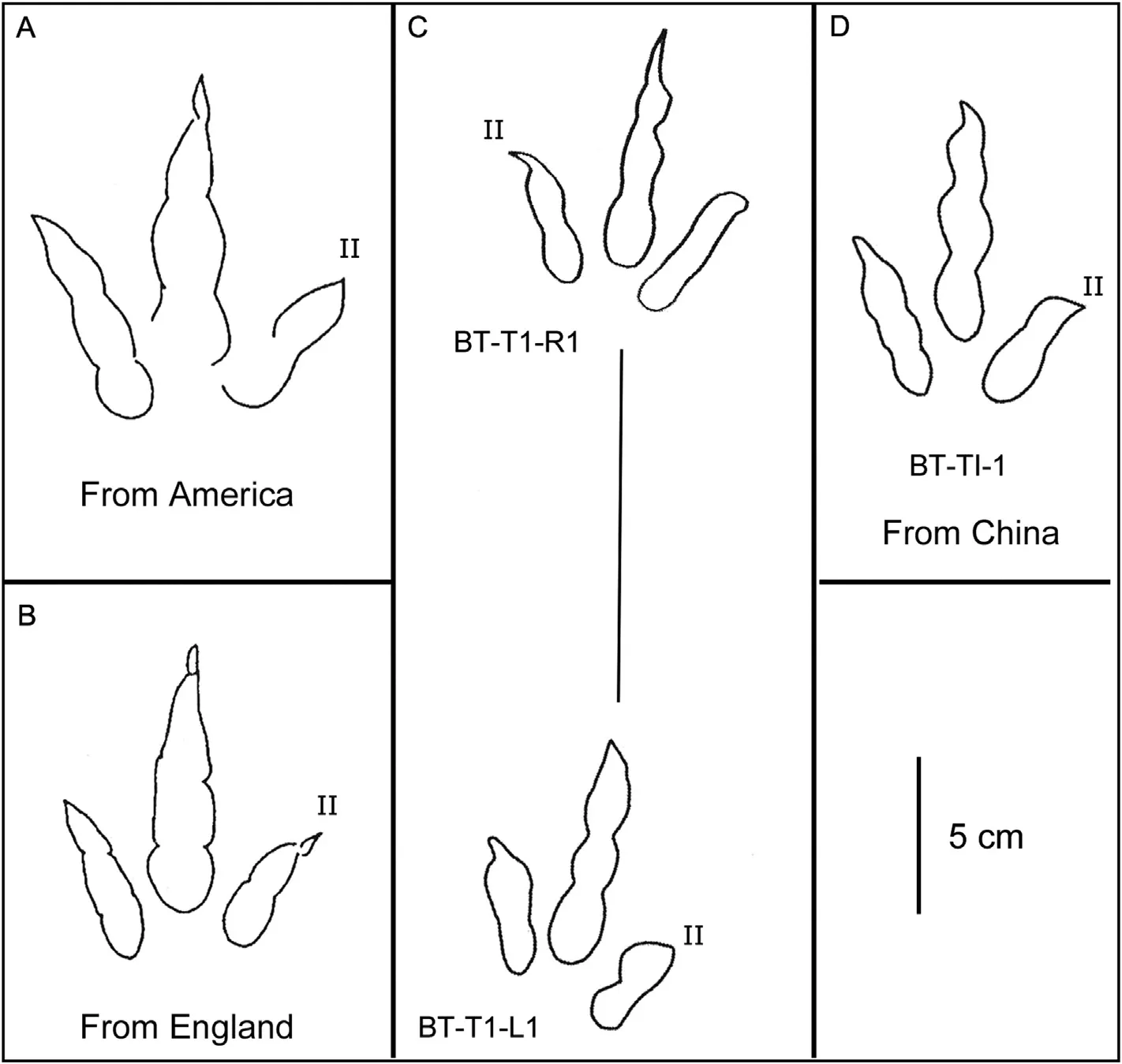
Fig.6 Comparison between A—Carmelopodus(CU-MWC 184.19)from the Middle Jurassic of America;B—Carmelopodus from the Middle Jurassic of England;C and D—Carmelopodus(BT-T1)from the Middle Jurassic Bingtu tracksite of southwestern China.
6. Dinosaur fauna
The discovery of footprints cf.Eosauropus in the Upper Triassic Xujiahe Formation suggests that basal sauropodomorph trackmakers from the Xichang Basin might be comparable to the producer of a possible Eosauropus trackway in the same unit near Zigong,Sichuan Basin(Xing et al.,2014b).They indicate thatbasal sauropodomorphs were possibly common in the Xujiahe Formation.Additionally,the track record of the Xujiahe Formation in the Sichuan Basin includes medium to large theropod tracks of Pengxianpus,together with mammal or mammal-like synapsid tracks from Peng County(Lockley and Matsukawa,2009;Xing et al.,2013a;Yang and Yang,1987),and small tridactyl theropod tracks,from Tianquan County(Xing et al.,2013a).Taken together,the track record indicates a diverse vertebrate fauna in the damp meandering fluvial—lakeshore delta facies of the Xujiahe Formation.

Table 2 A comparison of Carmelopodus specimens from America and China.
In the Rhaetian stage of the Triassic,dinosaurs underwent a further diversification.Apachean(late Norian—?Rhaetian)records of dinosaurs from the Upper Triassic series of New Mexico include skeletal fossils of Coelophysis as well as tracks of Grallator,Evazoum and Eosauropus(Heckert et al.,2000;Lucas et al.,2010).Trackmakers of Grallator may correspond to Coelophysis while those of Evazoum and Eosauropus are thought to have been small and large sauropodomorphs(Hunt et al.,1998;Lockley et al.,2000,2006a,b).The Xujiahe Formation has similar assemblages with the tracks of small-to medium-sized theropods and basal sauropodomorphs.
Middle Jurassic dinosaur faunas comprise abundant vertebrate body fossils that have been found in sand lenses of the Lower Shaximiao Formation, Sichuan Basin.This is the “Shunosaurus fauna”,with the theropods Szechuanosaurus and Gasosaurus,the sauropods Shunosaurus,Datousaurus,and Omeisaurus,the ornithopods Xiaosaurus and Agilisaurus,and the stegosaur Huayangosaurus(Peng et al.,2005).However,this assemblage does not include small theropods,possibly due to size-dependent variations in skeletal preservation.This gap seems to be filled now by the ichnological record.Carmelopodus tracks from the Shaximiao Formation of Xichang Basin represent the first record of small theropods in that area.For the theropod trackmakers of BT-T1,body lengths are estimated at 0.98—1.1m,using the average hip height to body length ratio of 1:2.63(Xing et al.,2009)and the formula hip height estimated as 4 times foot length(Henderson,2003)or 4.5 times foot length(Thulborn,1990).
7. Conclusions
1)Footprints from the Upper Triassic Xujiahe Formation and from the Middle Jurassic Shaximiao Formation of the Xichang Basin extend the geographic and stratigraphic distribution of some important ichnotaxa known from the global record.
2)Large-sized tracks from the Xujiahe Formation at the Yiguojiao tracksite are the fifth record from the Upper Triassic strata of China,and the first record to show diagnostic sauropodomorph tracks with similarities to morphotypes such as Eosauropus known from the Late Triassic of North America and Europe and Liujianpus known from the Early Jurassic of China.
3)The Middle Jurassic Bingtu tracksite yields the first dinosaur track in the Lower Shaximiao Formation and the first record of the characteristic Middle Jurassic ichnogenus Carmelopodus from China and Asia.
4)In addition to the skeletal record,the ichnofossils indicate the presence of a small sized(~1 m long)theropod trackmaker in the Middle Jurassic Shaximiao Formation.
Acknowledgements
This research project was supported by the National Natural Science Foundation of China(Grant No.41772008),the State Key Laboratory of Palaeobiology and Stratigraphy(Nanjing Institute of Geology and Palaeontology,CAS)(Grant No.173127),and the comprehensive geological and mineral survey in Wumeng mountainous area conducted by China Geological Survey(Grant No.121201010000150002).
We thank two anonymous reviewers and Prof.Stephen Kershaw for their constructive reviews that improved the manuscript largely.
 Journal of Palaeogeography2018年1期
Journal of Palaeogeography2018年1期
- Journal of Palaeogeography的其它文章
- Trace fossils of an amalgamated storm-bed succession from the Jurassic of the Kachchh Basin,India:The significance of time-averaging in ichnology
- Oxygenation in carbonate microbialites and associated facies after the end-Permian mass extinction:Problems and potential solutions
- Evolution of sedimentary facies and fossil communities in the Middle Permian Maokou Formation in Zigui County,Hubei Province,South China
- A redescription of the ichnospecies Koreanaornis anhuiensis(Aves)from the Lower Cretaceous Qiuzhuang Formation at Mingguang city,Anhui Province,China
- Geologic-seismic models,prediction of shallow-water lacustrine delta sandbody and hydrocarbon potential in the Late Miocene,Huanghekou Sag,Bohai Bay Basin,northern China
- Deeply concealed half-graben at the SW margin of the East European Craton(SE Poland)—Evidence for Neoproterozoic rifting prior to the break-up of Rodinia
